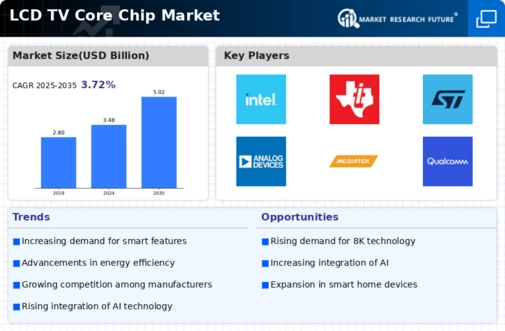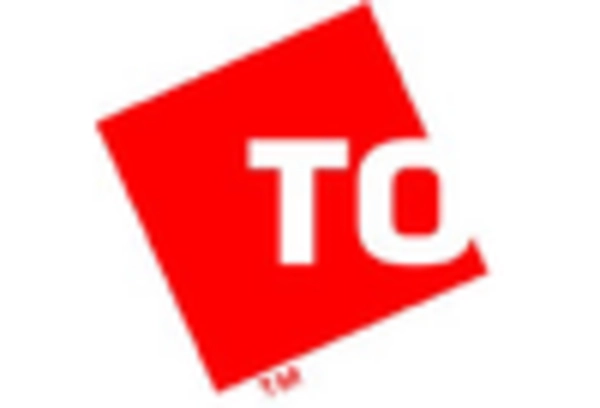Growth of Smart TV Segment
The proliferation of smart TVs is significantly influencing the LCD TV Core Chip Market. As more consumers adopt smart televisions, the demand for core chips that facilitate internet connectivity and smart features is on the rise. Reports suggest that the smart TV segment is expected to account for over 50% of total TV sales by 2025. This shift towards smart technology compels manufacturers to invest in advanced core chips that can handle complex applications and provide seamless user experiences. Consequently, the LCD TV Core Chip Market is witnessing a surge in research and development efforts aimed at enhancing chip capabilities to meet these evolving consumer demands.
Expansion of Content Streaming Services
The expansion of content streaming services is reshaping the landscape of the LCD TV Core Chip Market. As more consumers turn to streaming platforms for entertainment, the need for televisions equipped with powerful core chips that can handle high-bandwidth applications is increasing. This trend is expected to drive the demand for advanced processing capabilities in core chips, as they must support various streaming formats and resolutions. Projections indicate that the number of streaming subscribers will surpass 1 billion by 2025, creating a substantial market opportunity for manufacturers of LCD TV core chips. This shift towards streaming is likely to catalyze further innovation within the LCD TV Core Chip Market.
Technological Advancements in Chip Design
Technological advancements in chip design are propelling the growth of the LCD TV Core Chip Market. Innovations such as system-on-chip (SoC) architectures and improved fabrication processes are enabling the production of more powerful and efficient core chips. These advancements allow for better performance in terms of processing speed and energy consumption, which are critical factors for modern televisions. The market is projected to grow at a compound annual growth rate of approximately 8% through 2025, driven by these technological improvements. As manufacturers strive to create more compact and efficient designs, the LCD TV Core Chip Market is likely to experience a wave of new product introductions.
Rising Demand for High-Definition Displays
The increasing consumer preference for high-definition displays is a primary driver in the LCD TV Core Chip Market. As consumers seek enhanced viewing experiences, manufacturers are compelled to integrate advanced core chips that support higher resolutions and improved image quality. The market for high-definition televisions has seen a notable increase, with projections indicating that by 2025, over 70% of televisions sold will be 4K or higher. This trend necessitates the development of sophisticated core chips capable of processing large amounts of data efficiently, thereby driving innovation and competition within the LCD TV Core Chip Market.
Increasing Consumer Awareness of Energy Efficiency
Consumer awareness regarding energy efficiency is becoming a significant driver in the LCD TV Core Chip Market. As environmental concerns rise, consumers are increasingly seeking energy-efficient televisions that reduce electricity consumption. This trend is prompting manufacturers to develop core chips that optimize power usage without compromising performance. Data indicates that energy-efficient models are expected to capture a larger market share, with sales of energy-efficient TVs projected to rise by 30% by 2025. Consequently, the demand for advanced core chips that support these energy-saving features is likely to grow, further influencing the dynamics of the LCD TV Core Chip Market.

















Leave a Comment